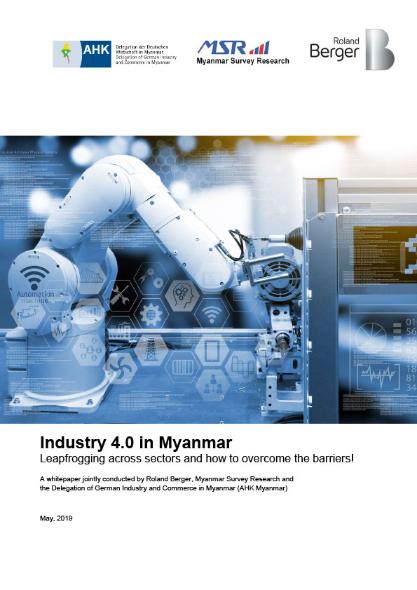Industry 4.0 in Myanmar – Leapfrogging across sectors and how to overcome the barriers!
![{[downloads[language].preview]}](https://www.rolandberger.com/publications/publication_image/Roland_Berger_529_Industry_4.0_in_Myanmar_Cover_download_preview.jpg)
The first comprehensive HR study in Myanmar reveals the challenges in finding and retaining talents and points out ways how to overcome it.


"Even though digitalization is still at an early stage, companies in Myanmar are already able to benefit from a fine telecommunication infrastructure and a population ready to embrace new technologies."
Myanmar and Industry 4.0 are not often used in the same sentence. Myanmar is better known for its infrastructure gaps and one could argue the country is far away from a transition towards Industry 4.0. A recent survey, conducted by AHK Myanmar, Myanmar Survey Research and Roland Berger with small & medium-sized manufacturing companies, reveals that only 8% of survey respondents have heard of Industry 4.0. However, the survey also shows a high level of willingness across Myanmar companies to automate their business activities. Since Myanmar has hardly participated in the industrialization of the past decades, there is vast potential for the country to leapfrog older technologies and shift immediately towards an era of automation and Industry 4.0.
As of today, various examples can be observed in Myanmar, which drive further digitization and automation in different industries. The telecommunication and financial sector have proven that leapfrogging is possible in a country like Myanmar. However, Industry 4.0 is about more than digitizing specific services. It entails the interconnectivity of a supply chain, even across industries, by using technology and data. Industry 4.0 offers vast opportunities on a corporate and on a macro-economic level. Roland Berger estimates that a typical manufacturing company, such as an automotive supplier, which today has an average profitability rate of 6%, can more than double its profitability to 13%, mainly by higher plant utilization. On a macroeconomic level, a positive net effect in job creation can be expected. While an increase in automation leads to a reduction in the employability of low skilled workers, it increases the demand for medium to high skilled staff and attracts more foreign direct investments.
These benefits are also seen by the companies in Myanmar, which are planning to continue to invest in the digitization and automation of their production facilities.
However, in order to reap the benefits of Industry 4.0, Myanmar needs to overcome five main barriers in the upcoming years:
If those barriers can be overcome, Myanmar has a unique opportunity to leapfrog across industries. However, it is important for all stakeholders to act NOW, act TOGETHER and act SELECTIVELY. Other countries in Southeast Asia (e.g., Thailand or Malaysia) have shown how Industry 4.0 can increase efficiency for companies and convenience for end-customers. Malaysia, for instance, has used a multi-layered approach, to foster automatization and digitization in the country. By following a clear roadmap and looking at successful neighboring countries, Myanmar can develop its own national Industry 4.0 strategy to further drive prosperity.

![{[downloads[language].preview]}](https://www.rolandberger.com/publications/publication_image/Roland_Berger_529_Industry_4.0_in_Myanmar_Cover_download_preview.jpg)
The first comprehensive HR study in Myanmar reveals the challenges in finding and retaining talents and points out ways how to overcome it.